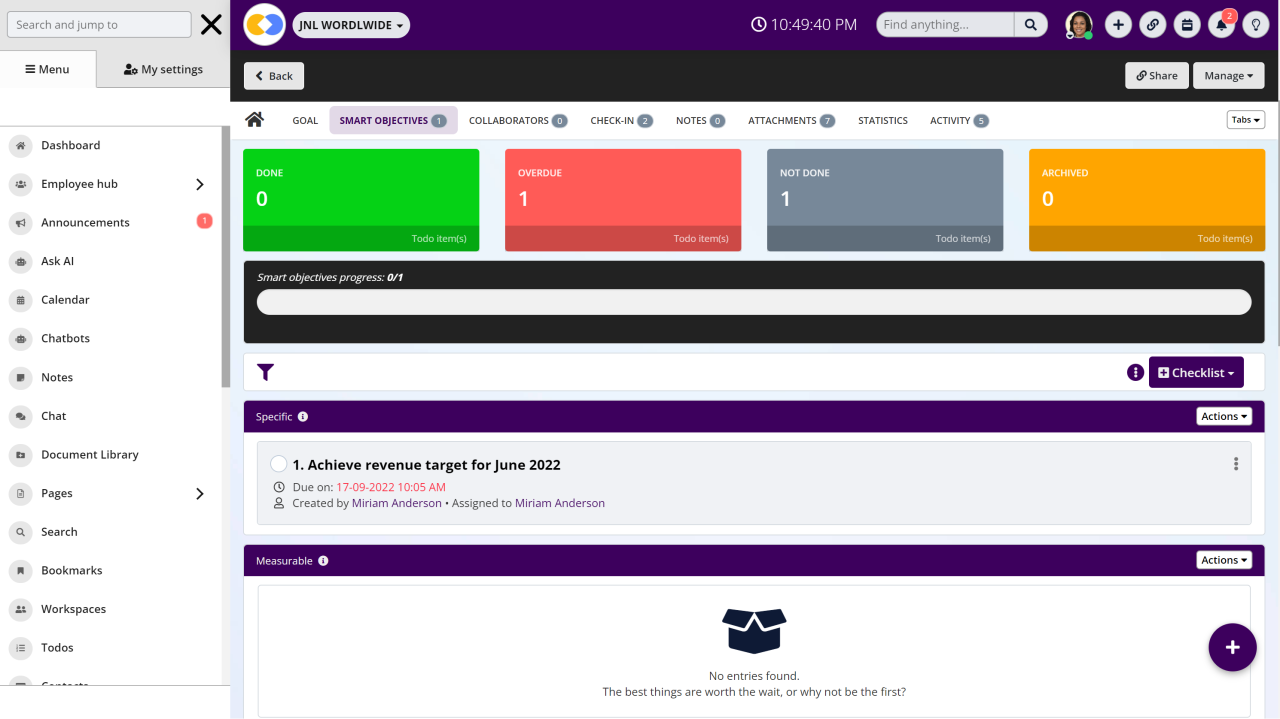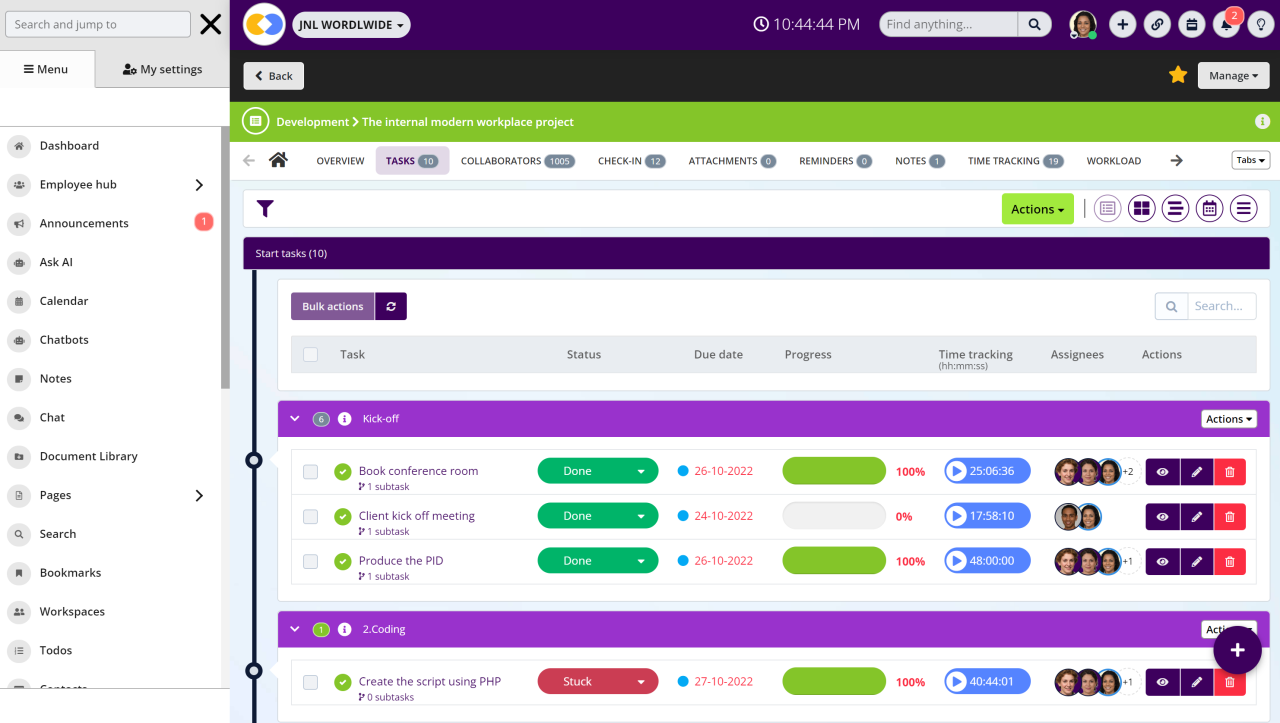Insight Blog
Agility’s perspectives on transforming the employee's experience throughout remote transformation using connected enterprise tools.
26 minutes reading time
(5211 words)
30 Project Management KPIs to Evaluate Productivity: A Complete Guide – UPDATED 2023
Explore crucial Project Management KPIs, their tracking methods, and their impact on project success.
Lets talk about Project Management KPIs, and how it can improve productivity in 2023.
A essential metric in project supervision, known as a key performance indicator (KPI), serves as a quantitative value for analyzing the overall effectiveness of a project in respect to the organization's goals. Adherence to budgetary limitations, timetables, objectives, and quality criteria are common measures of a project's success.
Stakeholders want to see if the project's outputs are in accordance with their strategic goals, whereas the Project Manager is focused on fulfilling deadlines and financial limits.
By closing the gap between these overarching aims and the project's specific objectives, KPIs in Project Management help to retain more project managers, employees, stakeholders, and customers. Intranet Metrics & KPIs – Understanding Intranet Analytics Best Practices
Furthermore, project management key performance indicators function as an exceptionally efficient monitoring instrument, aiding in the visualization of project progress through tools such as the Gantt chart. The Gantt chart offers a comprehensive overview of project tasks, timelines, and dependencies, allowing for better planning and coordination among team members.
These metrics may be utilized by the project manager to monitor the progress of the project over time and evaluate its conformity with the expected results.
Success metrics reflect a variety of methods to project completion.
Some common metrics used by project managers are listed below.
Read more on: 6 Essential SAAS Onboarding Metrics (KPIs) In 2023
What Are Project KPIs?
Key Performance Indicators (KPIs) in project management encompass distinct measurement approaches designed to gauge the efficiency with which teams achieve predetermined objectives.
Typically defined in the project's initial phases, these KPIs mirror the core project concept and solidify commitment across organizational departments.
Despite the diverse responsibilities within each team, individual contributions collectively shape the KPIs.
A comprehensive grasp of the role KPIs play in project management facilitates the cultivation of team synergy and provides a framework for capturing the essential information necessary to monitor the overall success of corporate projects.
By integrating KPIs strategically, project teams can align their efforts, ensuring a cohesive approach towards attaining project goals.
Understanding KPIs for Project Success
You can use KPIs for project success as they are the measurements most closely related to an organization's primary objectives, as stated by Stanford University.
The focus in this explanation is on "vital organizational goals". Many metrics will be gathered during the life of a project, but only few of them will be considered key performance indicators.
Key performance indicators are used to monitor development in many domains, including:
- Business
- Asset Management
- Program Administration, or
- Targeted Projects
By keeping a close eye on key performance indicators, project managers may pinpoint:
- Successes
- Areas that need attention, and
- Potential problems down the road if the present trend continues
With this knowledge at their disposal, they may make educated decisions and adjust their approach in light of the results.
What Makes a Good KPI for Project Management?
Key performance indicators (KPIs) play an integral role in gauging the effectiveness of team contributions throughout various facets of a project. To ensure the efficacy of KPIs in project management, adhere to the following principles:
- Establish Consensus Early On:
- Prior to project initiation, secure agreement from all stakeholders on the selected KPIs.
- Tailor KPIs to the Audience:
- Align KPIs with the unique needs and objectives of the intended audience to enhance relevance.
- Quantify and Share Metrics:
- Ensure KPIs are measurable and readily shared, fostering cross-departmental review and analysis.
- Regularly Monitor Progress:
- Consistently track KPIs to assess project performance, enabling the identification of areas for improvement.
- Guide Decision-Making:
- Utilize KPIs as a foundation for making informed decisions at various stages of the project lifecycle.
- Align with Project Goals:
- Directly align KPIs with the overarching objectives of the project for cohesive progress tracking.
- Prioritize Realism and Efficiency:
- Craft realistic, cost-effective KPIs tailored to the company's culture, limitations, and timeframe.
- Integrate with Organizational Efforts:
- Ensure KPIs align seamlessly with broader organizational goals and initiatives.
- Reflect Company's Success Factors:
- Capture and reflect the key elements driving success for the organization within chosen KPIs.
KPIs serve as invaluable tools in project management, empowering organizations to realize their strategic objectives. Through the consistent tracking and analysis of data from various teams, organizations can pinpoint areas necessitating additional guidance, incentives, planning, or resource allocation, such as training. This strategic approach facilitates enhanced project performance and overall organizational success.
4 Tips for Creating and Using Project KPIs Effectively
Once the team has identified the KPIs crucial for assessing performance, it's essential to follow best practices for effective tracking:
- Make Your KPIs Clear and Focused:
- Utilize KPI templates for project management, ensuring that KPIs adhere to the S.M.A.R.T. criteria:
- S - Specific
- M - Measurable
- A - Attainable
- R - Realistic
- T - Time-based
- Utilize KPI templates for project management, ensuring that KPIs adhere to the S.M.A.R.T. criteria:
- Choose Your Measures With Purpose:
- Select a limited number of key metrics directly aligned with your goals. If a KPI lacks clear significance, consider removing it. Remember, a higher number of KPIs results in increased reporting time.
- Always Include a Target:
- Even for organizations with limited historical data, incorporate targets for selected KPIs. Use industry research or past data to make informed estimates.
- Know When to Abandon a KPI:
- Regularly assess the utility of each KPI in organizational decision-making and strategy meetings. If a KPI isn't contributing value, reconsider its inclusion to avoid unnecessary tracking efforts.
Following these best practices ensures that the chosen KPIs are not only relevant but also contribute meaningfully to the organization's overall performance assessment.
Follow us and access great exclusive content everyday: Follow us on Google News
How to Define Project Management KPIs
To ensure that your project management KPIs effectively serve as SMART goals, adhere to the following guidelines:
- Specific and Clearly Defined:
- Provide a clear and unambiguous definition for each identified KPI. Ambiguous KPIs result in immeasurable success, missed deliverables, and unfulfilled objectives throughout the project lifecycle.
- Measurable Using Accurate Data:
- Rely on accurate data to measure the success of project management KPIs. Gathering consistent and precise data ensures that KPIs are quantifiable and easily reportable, preventing reliance on multiple sources or educated guesses.
- Achievable and Realistic:
- Set KPIs at achievable levels for project teams to maintain motivation. If KPIs are overly ambitious, team members may become demotivated, leading to low morale and a lack of evaluation.
- Relevant to the Objective:
- Ensure that KPIs directly align with the project's objectives. Regularly review KPIs contributed by various team members to eliminate irrelevant ones and maintain alignment with the project's overall goal.
- Time-Bound and Actionable:
- Acknowledge the non-linear nature of projects by creating time-bound and actionable KPIs applicable at any project stage. These KPIs should guide the team, providing specific milestone deadlines even in the presence of deviations from the initial plan.
By following these guidelines, project management KPIs can effectively function as SMART goals, contributing to the success and progress of the project.
30 Most Important Project KPIs Examples
Here are project KPIs examples that cover all aspects of a project management:
You may also like: Best Apps for Employees: UPDATED 2022 – A Complete Guide
Key Performance Indicator #1: Net Profit
The amount of money made after all expenses have been deducted is called "net profit." It is calculated by deducting the entire income for the project from the total cost of all project resources.
This key performance indicator may be evaluated after the project is complete, or it may be tracked on a more frequent basis if revenue begins to flow in before the project is fully wrapped up.
Maximizing financial advantages requires a thorough understanding of net profit. This powerful statistic unavoidably impacts corporate choices, regardless of whether it is being monitored.
Key Performance Indicator #2: Earned Value (EV)
It is used to quantify the actual monetary value that has been used to complete the task, juxtaposed against the original budget.
The formula for this KPI is:
Earned Value = % of completed work x original budget
This measurement can be applied either to the entire project or specific tasks/groups of tasks with allocated budgets.
Consider a task with a $1,000 budget. If 75% of the task is finished, the EV for this task would be $750.
EV = 75% x $1,000 = $750
EV often functions as an integral component in Earned Value Management, essential for calculating other KPIs like cost variance (CV).
Free ebook: How To Get Your Intranet Off The Ground
Key Performance Indicator #3: Budget Variance
The success of an attempt may be judged in large part by looking at the discrepancy or gap that develops between actual expenditure and planned or projected expenditure. It's a great indicator of how closely current events are tracking with one's preconceived notions. When this kind of variation becomes obvious, it sends a strong message to supervisors and superiors.
This indicator causes them to take preventative measures to fix the problem and keep the project on track. Managers may guarantee the project stays on track and under budget by recognizing and rectifying any discrepancies in financial outlays, increasing the likelihood of a successful outcome.
Key Performance Indicator #4: Return on Investment (ROI)
The return on investment, or ROI, of a project is one of the most important ways to measure its success. You can easily calculate by dividing the net profit by your initial investment and multiplying it by hundred.
This method is one of the most basic ways to figure out how much money a project makes or loses. Using ROI as a key success measure makes it easier to get a full picture of the project's value-creation potential. By looking closely at the ROI, stakeholders can learn a lot about how profitable and efficient the project is, which can help them make better decisions.
Key Performance Indicator #5: Planned Value (PV)
Earned value and planned value, which is often written as PV, are similar, but planned value is still important as a separate KPI.
PV is a very important tool for showing how much money has been set aside for each job in a project. To figure it out, increase the amount of work that still needs to be done by the total project budget:
Planned Value (PV) = Percentage of Remaining Work × Total Budget
To simplify with a straightforward example, let's consider a scenario where the objective is to manufacture 1000 computer keyboards, each priced at $100, at a production rate of 20 keyboards per day.
This project spans a duration of 20 days, with an Estimated Budget at Completion (BAC) of $10,000, representing the anticipated cost.
In this context, if the value increases incrementally by $1,000 each day. Therefore, at the conclusion of the tenth day, the anticipated planned value for this project stands at $5,000.
Planned value serves as a valuable tool for monitoring project progression by assessing the value generated. This evaluation involves comparing it with earned value and actual cost, enabling a comprehensive evaluation of the project's financial performance.
Key Performance Indicator #6: Actual Cost (AC)
It is a KPI that shows how much a job cost all together. AC is different from other KPIs because it doesn't have a simple method. It shows how much money has been spent up to the point of calculation. If you've already spent $100,000 on the project, for example, the Actual Cost at that point is $100,000.
AC is useful on its own, but it's also needed to calculate many of the other KPIs in this book. AC can be put next to Planned Cost to see how well the budget is being followed.
Key Performance Indicator #7: Cost Performance Index (CPI)
This KPI indicates whether you are over or under budget. The CPI calculation involves dividing a what the project has earned by the financial resources you have spent.
Continuing with the initial case: if building 20 keyboards was budgeted at $5,000 but the actual expense was $5,600, the CPI would be 0.89.
CPI = 5,000 / 5,600 = 0.89
This means that for every dollar spent, the project realizes a value of $0.89. Thus, CPI, with its percentage-based output, is crucial for assessing a project's cost-effectiveness.
Key Performance Indicator #8: Cost Variance (CV)
This KPI is similar to CPI, but it shows data in terms of real dollar amounts instead of percentages. This makes it easy to see how far off the planned budget was.
Here's how to figure out CV:
CV = AC – EV
Going back to the keyboard case, the Cost Variance for making 20 keyboards is $600 less than what it would have been.
CV = $5,000 – $2800 = -$300
If the value is in negative it shows that you are spending more than you wanted.
Key Performance Indicator #9: Schedule Performance Index
This is an important KPI that measures how strictly you are following the schedule.
SPI = PV / EV
In the case of the keyboard project, the planned value (PV) by day 10 was $5,000, based on the idea that 20 would be made every day and sold for $100 each. So, a PV of $5,000 is found for 100 keyboards that cost $100 each.
The Earned Value (EV) is $4,300 if only 86 keyboards are made by day 10.
In this case, the SPI would be 0.86.
SPI = 4,300 / 5,000 = 0.86
Key Performance Indicator #10: Schedule Variance (SV)Enter heading here...
Schedule Variance (SV) is a KPI indicating whether a project is adhering to its scheduled timeline.
The formula for SV is:
SV = EV – PV
Interpreting SV is straightforward:
●You're on track if SV equals 0,
●You're behind schedule if SV is less than 0,
●You're ahead of schedule if SV is greater than 0.
SV distinguishes itself from other temporal KPIs by measuring project progress against planned progress rather than time elapsed.
Key Performance Indicator #11: Planned Hours vs Time Spent
This KPI compares the actual time taken to achieve a certain level of progress with the project manager's initial time estimate. Unlike schedule variance, this KPI uses hours as its unit of measurement, not value.
The planning fallacy often causes a disparity between estimated and actual hours, reflecting the tendency to underestimate time requirements, even when past experiences suggest otherwise.
Simply deduct actual hours from planned hours to calculate this KPI. The closer the result is to 0, the more aligned you are with the schedule. Negative figures indicate delays, while positive ones suggest being ahead.
Tracking this KPI allows project managers to spot early indications of succumbing to the planning fallacy and to adjust timelines as needed.
Key Performance Indicator #12: Cycle Time
Cycle Time measures the duration taken to complete a task from its inception.
This KPI is particularly crucial in Kanban methodologies for identifying process blockages. It's well-suited to Kanban as it emphasizes singular task focus, enhancing the accuracy of cycle times.
Beyond identifying bottlenecks, calculating average cycle times assists project managers in forecasting project durations and crafting more precise schedules.
Key Performance Indicator #13: Lead Time
The lead time for a project is calculated from the moment it is requested, not the time work begins. Lead times are a good indicator of a team's productivity since shorter lead times indicate more efficiency.
How quickly a team implements new features or fulfills orders is also shown here. The escalation of lead times may indicate the presence of issues, such as the incorrect prioritization of jobs.
So, it's an excellent approach to check how things are going and identify any problems.
Key Performance Indicator #14: Resource Capacity Utilization
Resource Capacity (RC) Utilization is a critical KPI for projects utilizing shared resources. It assesses the proportion of scheduled resource use against the resource's total capacity.
Schedule Utilization = scheduled time / resource capacity
A common application involves team members' availability. For instance, if Jane, a graphic designer with an 8-hour workday, is allocated 5 hours daily on a project while also committed to another project for 6 hours, the numbers reveal a capacity issue. This formula applies to all resources, including key equipment.
Key Performance Indicator #15: Customer Satisfaction Score (CSAT)
This KPI assesses how pleased consumers are with your product, service, or support. Asking respondents to rank something on a scale from 1 to 5 is a common way to get this information.
The bad ratings might teach you crucial lessons about how to improve your service and make your clients happy. A low rating indicates that there may be some faults or troubles that users are encountering. Taking care of these issues is a great first step in ensuring your customers are delighted with your products and services.
Calculate CSAT as follows:
CSAT = total of all response scores / count of responses
Key Performance Indicator #16: Net Promoter Score (NPS)
This indicator uses surveys to learn about customers' experiences is the Net Promoter Score (NPS), which is similar to CSAT.
The responses are then divided into three categories:
●Users who gave you a score of 9 or 10 are considered Promoters, since they are committed to spreading the word about your product or service.
●Customers with passive satisfaction (Scores 7-8) are happy with your service but may not go out of their way to tell others about it. They fall in the center of the spectrum.
●Customers who gave you a score of 0 to 6 are considered detractors since they may not purchase from you again and may even prevent others from giving your product a go.
By knowing where your users sit on this scale, you may receive insights into how pleased they are and if they're likely to assist or hurt your company via word-of-mouth referrals.
Here is how you can calculate NPS:
NPS = percentage of promoters – percentage of detractors
For instance, with 50% promoters and 17% detractors, NPS is 33%.
NPS = 50 – 17 = 33
NPS ranges between -100 and 100.
Key Performance Indicator #17: Number of Change Requests
This key performance indicator tracks the number of client-requested adjustments that result in a broadening of the project's scope. Frequent requests for changes by customers might reduce the quality of your work and increase the likelihood that things won't go according to plan.
It's like you're attempting to make a dish according to a certain recipe, but everyone keeps asking to switch up the components. Too many alterations to the recipe might result in a meal that doesn't taste quite right.
Key Performance Indicator #18: Number of Returns
If we're working on a project involving a tangible good, we may learn a lot about its quality and the extent to which clients are satisfied with the goods they send back.
In a similar vein, the rate of product returns from third-party contractors may provide light on the completeness of your project planning and the quality of the contractor's work.
So, in both circumstances, returned objects serve as a signal that tells you how things are progressing and if there are any problems that require fixing.
Key Performance Indicator #19: Number of Errors Found
This key performance indicator tracks the number of errors found throughout many stages:
●Quality Assurance (QA) stage,
●During the code review process, and
●By customers
At each level, detecting mistakes informs us a lot about how the project is developing. The discovery of mistakes indicates the potential for remedial action. This may affect the project's timeline and budget.
It's like when you bake a cake and discover a mistake in the batter, the icing, or when you're eating it; you need to figure out what went wrong in order to avoid the same mistakes in the future.
Key Performance Indicator #20: Employee Churn Rate
In business, the rate at which people quit their positions is measured by the Employee Churn Rate, commonly known as turnover. In layman's terms, it reveals the total number of employees leaving throughout that time frame.
This indicator is helpful for businesses in gauging the consistency of their staff. Employee unhappiness or difficulties with the company's culture might be to blame for a high turnover rate.
Conversely, a low turnover rate is an indication that workers are more likely to remain with the organization, which is a good indicator.
Here is how to calculate it: divide the number of employee who have resigned to the employees still in your company and multiply it by hundred.
Key Performance Indicator #21: Percentage of Canceled Projects
This indicator reflects the relationship between project management techniques and final results. Studies on project management and research have both shown that attempting to juggle too many tasks at once increases the likelihood of anything going wrong. When businesses bite off more than they can chew, it generally leads to resource limits, extended timeframes, and degraded project quality.
By tracking the proportion of projects that are canceled, companies receive vital information about their potential for efficiently managing a number of projects simultaneously.
To guarantee the effective execution of projects and, by extension, the attainment of organizational goals, this KPI should act as a warning light, reminding decision-makers of the significance of finding a balance between ambition and the realistic allocation of resources.
Key Performance Indicator #22: On-time Completion
One of the most important metrics is on-time completion, which measures how many projects are finished before their due dates. The accuracy of a project's schedule may be judged in large part by this statistic.
Are initiatives on schedule and fulfilling their time-based goals? is a question that this essentially answers. A high percentage of projects completed on schedule is indicative of well-organized planning and timely execution.
A lower rate, on the other hand, may point to problems with the project's design, allocation, or execution.
Key Performance Indicator #23: Milestones Completed on Time
A key metric, on-time completion of milestones, places emphasis on work for external clients and the leverage it may provide in negotiations.
This statistic requires keeping a careful eye on the percentage of client-approved milestones that are fulfilled within their allotted time period, as opposed to the percentage that are missed or postponed.
Delivering on commitments and meeting customer expectations is shown in this key performance indicator.
By routinely accomplishing on-time milestone fulfillment, organizations may strengthen their reputation, build excellent client relationships, and gain a strategic advantage in obtaining and maintaining customers.
Key Performance Indicator #24: Billable Utilization
Billable utilization is a key performance indicator since it measures the percentage of time a business spends on billable activities. Hours that may be billed to clients are those that are spent working on projects, rather than doing things like paperwork or research.
Improving profitability and gauging an organization's financial health rely heavily on this indicator. The effectiveness with which workers prioritize tasks that directly result in income may be measured by keeping tabs on billable usage. A high billable utilization rate is an indicator of efficient use of resources, which in turn boosts earnings and business viability.
A low billable usage rate, on the other hand, might point to problems with the way resources are being allocated or managed. Therefore, this key performance indicator acts as a diagnostic tool, enabling businesses to zero in on areas for monetary and operational improvement.
You can calculate it as:
Billable Utilization = (Billable hours / Total hours) x 100
Professional billable utilization services can answer any questions about this KPI. One of the key features of professional billable utilization services is their ability to establish and refine utilization targets.
This typically involves defining both maximum and minimum utilization thresholds tailored to the specific needs and goals of the organization.
These targets serve as benchmarks to gauge the efficiency and productivity of professional services teams.
Key Performance Indicator #25: Project Velocity
Project Velocity is a helpful tool for Scrum teams since it measures how much work is completed throughout each Sprint. This metric is useful for tracking performance over the course of many Sprints and estimating what can be accomplished in future iterations.
Note that Project Velocity is more of a planning statistic than an actual assessment of performance. Its primary function is to assist teams estimate how much work they can get done in upcoming Sprints.
So, how can you apply this concept in real work settings? Consider a scenario where a development team is working on an e-commerce website, employing time-boxed iterations, typically lasting two weeks each. At the outset of each Sprint, the team estimates their potential work output based on historical performance, referred to as Project Velocity.
For instance, if the team completed 20 story points in the previous Sprint, the Project Velocity for the upcoming Sprint might be set at 20 story points. This doesn't guarantee a consistent output but provides a planning baseline.
The team chooses tasks from the product backlog based on this estimated velocity, aiming to commit to a realistic amount of work. As the Sprint progresses, adjustments are made based on the actual progress.
The iterative nature of this process helps refine estimation skills over time.
Key Performance Indicator #26: Six Sigma Level
Defects per million opportunities (DPMO) are quantitatively measured using Six Sigma, a popular technique for improving processes.
There are a maximum of 3.4 faults per million possible outcomes (or 0.00034%) at the sixth and highest level on this scale.
Your company's Six Sigma progress may be measured by determining its DPMO. This then helps us calculate the percentage of defects and the yield. Better overall performance and more satisfied customers are the results of a higher Six Sigma level, which is accomplished by reducing the defect rate and increasing the quality of the process.
Key Performance Indicator #27: Process Downtime
Projects that rely on customer-facing infrastructure cannot afford any interruption in their processes.
Picture yourself in charge of a large cloud server where the websites and user experience of your clients are immediately affected by any outage. Service availability, the frequency of interruptions, and the length of disruptions are only few of the combined KPIs that must be monitored in order to accurately assess and remedy such important circumstances.
Together, these KPIs provide a 360-degree perspective of infrastructure health, enabling businesses to prevent downtime, improve customer happiness, and keep services running smoothly.
Key Performance Indicator #28: Conversion Rate
When evaluating the success of a system or platform, the Conversion Rate KPI is crucial. It measures the proportion of users that successfully complete a given intended activity. This KPI is particularly important in the world of SaaS systems.
It may entail monitoring many crucial activities, such as the conversion of landing page visitors into registered account holders or the move from free to paid customers.
Conversion rate analytics provides businesses with crucial information about user engagement and the efficacy of their tactics in encouraging users to perform the actions that will lead to the expansion and longevity of their SaaS initiatives.
You can calculate it as:
Conversion Rate = total conversions / total interactions
Key Performance Indicator #29: Bounce Rate
As KPI, the Bounce Rate measures how successful a website is at keeping visitors on the site. It measures how many people visit a website but leave after just seeing at one page, much as how many people leave an art museum after only seeing one piece.
The method for determining the Bounce Rate is simple: the Bounce Rate = the total number of visits / the number of visitors that only saw one page.
A useful indicator for improving online content and design, it assesses a website's capacity to attract and retain visitors by tracking how long they spend on the site and what pages they see.
You can calculate it by using this formula:
Bounce Rate = one-page visits / total visits
Key Performance Indicator #30: Click-Through Rate (CTR)
When gauging the success of marketing and search engine optimization initiatives, the click-through rate (CTR) is a crucial key performance indicator (KPI).
The ratio of clicks to impressions gives useful information about the effectiveness of an advertisement or website. CTR is a proxy for how interesting and engaging a piece of information is to its intended audience.
When the CTR of an ad or website is high, it shows that many individuals who saw it felt compelled to take some kind of action in response to it.
As a result, click-through rate (CTR) is an essential indicator for enhancing SEO and measuring the efficacy of advertising, allowing businesses to fine-tune their online tactics for more user engagement and the generation of the intended outcomes.
Why KPIs Matter in Project Management?
Planning a travel from Florida to New York but winding up in Texas isn't only a navigation blunder; it underscores the necessity of heeding important signposts along the road.
Key Performance Indicators (KPIs) are like road signs, pointing the way ahead in the world of project management.
Key performance indicators (KPIs) strategically selected and implemented reveal valuable insights, such as performance trends and trajectories, proximity to or departure from set objectives, budget utilization efficiency, strategy efficacy, and areas of a project requiring attention.
Measuring key performance indicators (KPIs) enables project managers to quickly detect and fix problems, providing early warning of impending crises. Conversely, successful KPI results serve as inspiration and endorsements, reinforcing the team's commitment to the project and its forward momentum.
Tracking KPIs in Project Management
Key performance indicators in project management need a systematic strategy to monitoring.
To properly monitor KPIs, start by picking the particular indicators that fit with your project's goals.
You should base these KPIs on the most important parts of your project that can be tracked and enhanced. After finalizing your selection, set measurable goals or benchmarks for each key performance indicator and decide how often you'll be taking measurements (daily, weekly, monthly, etc.).
In order to reliably gather data on your chosen KPIs, you need set up a tracking system or use the relevant software tools. It's important to keep your team updated on the project's progress and any trouble spots by regularly disseminating key performance indicator data.
In order to obtain insights, make educated choices, fine-tune tactics, and steer the project toward success, it is important to remember that KPI monitoring is a continuous process that requires continual effort.
Wrapping up
Several project management KPIs, their significance, and a methodical strategy to tracking them have been outlined in this article. KPIs are very helpful when chosen thoroughly, objectives are clearly defined, metrics are tracked regularly, and teams communicate often. They provide light on things like efficiency of approach, spending patterns, and possible dangers to a project. Consistently reviewing project management KPIs aids in not just spotting problem areas but also reinforcing success as it progresses.
Categories
Blog
(2618)
Business Management
(320)
Employee Engagement
(210)
Digital Transformation
(174)
Growth
(119)
Intranets
(119)
Remote Work
(61)
Sales
(48)
Collaboration
(37)
Culture
(29)
Project management
(29)
Customer Experience
(26)
Knowledge Management
(21)
Leadership
(20)
Comparisons
(6)
News
(1)
Ready to learn more? 👍
One platform to optimize, manage and track all of your teams. Your new digital workplace is a click away. 🚀
Free for 14 days, no credit card required.

















